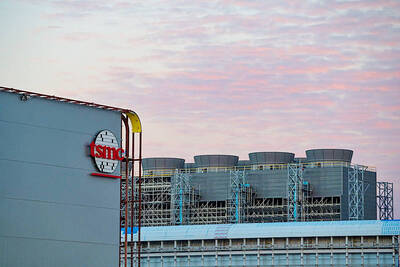The government is accelerating efforts to develop renewable energy, mainly wind power, to guard against a sustained rise in fuel costs, government officials said yesterday.
Taiwan is an energy-dependent nation that imports 98 percent of its fuel each year.
As a result, skyrocketing prices for oil and coal have weighed on the state-run Taiwan Power Co (Taipower,
Taipower, the nation's sole power supplier, is now paying more than double what it paid for coal a year ago, while the possibility of an impending energy crisis appears to have prompted the government to accelerate efforts to develop homegrown energy sources.
"We hope that by 2010 renewable power will account for 10 percent of the nation's electrical capacity, up from 5.4 percent now," Wang Yunn-ming (
Wang said the Cabinet last month asked Taipower to raise its electricity purchase quota from 30,000 kilowatt per year to 600,000 kilowatt per year at a purchase price of NT$2 per kilowatt hour. The measure will mostly benefit wind-power developers, he added.
As a form of renewable and clean energy that has higher cost efficiency than other renewable power sources such as solar energy and hydraulic power, wind power has been chosen by Taipower, as well as various private companies, as a major energy source to exploit, Wang said.
"We estimate that wind power will make up 80 percent of our 10 percent renewable-energy capacity by 2010," Wang said.
Taipower has already set up four windmills in Penghu County that generate 2,400 kilowatts of electricity per year, and is establishing wind-power stations in Taipei County, Taoyuan County and Hsinchu County, which in total are expected to generate about 100,000 kilowatts of electricity per year, said Yu Sheng-hsiung (
Private companies have been showing high interest in exploiting the nation's rich wind-power resources. Last year, German power company Infra Vest Windpower Corp started to build the nation's largest wind-powered electricity plant in Chiayi County. Under the plan, the company will build 70 wind-turbine generators at the plant, which will be capable of generating 200 million kilowatts per year. The company is scheduled to launch the power plant next year. The company plans to build additional plants in Taoyuan and Changhwa.
One independent power company based in Hsinchu, called Hsin Feng (
Formosa Heavy Industries Corp (
Overall, there will be 200 wind turbines scattered along the west coast of Taiwan within five years, Yu said.
However, wind power still holds risks -- if there's no wind, there's no power.
Therefore, the government will still develop other renewable resources, such as hydraulic power, said Taipower Spokesman Lee Jiin-tyan (
Lee said that though it may cost Taipower NT$10 billion (US$294 million) to repair hydroelectric plants along the Tachia River in Taichung County that were damaged in Tropical Storm Mindulle last month, the company will not give up on that source of clean energy.

Shiina Ito has had fewer Chinese customers at her Tokyo jewelry shop since Beijing issued a travel warning in the wake of a diplomatic spat, but she said she was not concerned. A souring of Tokyo-Beijing relations this month, following remarks by Japanese Prime Minister Sanae Takaichi about Taiwan, has fueled concerns about the impact on the ritzy boutiques, noodle joints and hotels where holidaymakers spend their cash. However, businesses in Tokyo largely shrugged off any anxiety. “Since there are fewer Chinese customers, it’s become a bit easier for Japanese shoppers to visit, so our sales haven’t really dropped,” Ito

The number of Taiwanese working in the US rose to a record high of 137,000 last year, driven largely by Taiwan Semiconductor Manufacturing Co’s (TSMC, 台積電) rapid overseas expansion, according to government data released yesterday. A total of 666,000 Taiwanese nationals were employed abroad last year, an increase of 45,000 from 2023 and the highest level since the COVID-19 pandemic, data from the Directorate-General of Budget, Accounting and Statistics (DGBAS) showed. Overseas employment had steadily increased between 2009 and 2019, peaking at 739,000, before plunging to 319,000 in 2021 amid US-China trade tensions, global supply chain shifts, reshoring by Taiwanese companies and

Taiwan Semiconductor Manufacturing Co (TSMC, 台積電) received about NT$147 billion (US$4.71 billion) in subsidies from the US, Japanese, German and Chinese governments over the past two years for its global expansion. Financial data compiled by the world’s largest contract chipmaker showed the company secured NT$4.77 billion in subsidies from the governments in the third quarter, bringing the total for the first three quarters of the year to about NT$71.9 billion. Along with the NT$75.16 billion in financial aid TSMC received last year, the chipmaker obtained NT$147 billion in subsidies in almost two years, the data showed. The subsidies received by its subsidiaries —

Taiwan Semiconductor Manufacturing Co (TSMC) Chairman C.C. Wei (魏哲家) and the company’s former chairman, Mark Liu (劉德音), both received the Robert N. Noyce Award -- the semiconductor industry’s highest honor -- in San Jose, California, on Thursday (local time). Speaking at the award event, Liu, who retired last year, expressed gratitude to his wife, his dissertation advisor at the University of California, Berkeley, his supervisors at AT&T Bell Laboratories -- where he worked on optical fiber communication systems before joining TSMC, TSMC partners, and industry colleagues. Liu said that working alongside TSMC